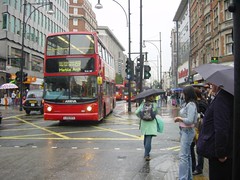A typical red London double-decker bus
(Flickr photo by Amajunior.)
After I wrote the other blog entry, I sent a query to Ian Wingrove, who is the press officier for the London Assembly Green Party (we're both on a particular e-list) and he wrote:
· The Hybrid double-decker bus has been built by WrightBus Limited. I think they are based in Northern ireland
· The London Bus fleet includes 8,000 buses on 700 routes, carrying over 6m passengers per day;
· The 8,000 strong London Bus fleet is the cleanest in the UK;
· All buses in the London fleet meet at least euro II emissions standards and have particulate traps, 60% meet Euro III standards and are also fitted with particulate traps, and buses meeting Euro IV standards are now being introduced;
· The current hybrid buses are powered by a small diesel engine and electric power, thereby cutting emissions by up to 40% per bus.
The technology works through a battery pack providing power to the wheels via an electric motor. The battery pack is kept at optimum power by a diesel Euro IV engine, keeping the battery charged. When the vehicle brakes, energy which would normally be wasted is also recycled and used to charge the battery. Thanks to continuous charging of the battery, the vehicle can meet the existing range of a conventional diesel bus.
(I got to thinking about these buses while poking through some of the Guardian's coverage of "Transport in Britain."




0 Comments:
Post a Comment
<< Home